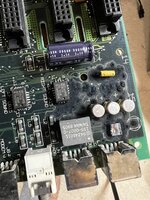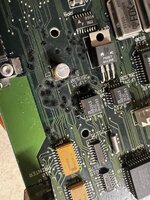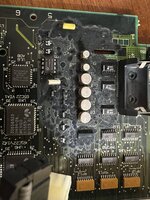-
Updated 2023-07-12: Hello, Guest! Welcome back, and be sure to check out this follow-up post about our outage a week or so ago.
You are using an out of date browser. It may not display this or other websites correctly.
You should upgrade or use an alternative browser.
You should upgrade or use an alternative browser.
Cap Goo Horror Story IIcx
- Thread starter macuserman
- Start date
macuserman
Well-known member
Nope? That’s a thing?Have you seen @max1zzz's IIcx clone board?
3lectr1cPPC
Well-known member
What. On. Earth.
I’ve never seen anything like this before. That doesn’t look like any kind of cap leakage I’ve EVER seen either… neither brown or green but BLACK? That looks more like a fungus or mold but nope it’s clearly coming from the caps… almost looks burnt. I wonder when those caps first leaked. Would have had to be back in the 90s plus being stored very poorly… I’m still wondering what on earth could have turned the board black like that. That looks nothing like the cap leakage I’ve ever seen, photos or in person.
Still, it’s weird. If you look some areas right around the caps look completely fine in small patches. Would like to see a photo of this board cleaned to see the extent of the damage.
I’ve never seen anything like this before. That doesn’t look like any kind of cap leakage I’ve EVER seen either… neither brown or green but BLACK? That looks more like a fungus or mold but nope it’s clearly coming from the caps… almost looks burnt. I wonder when those caps first leaked. Would have had to be back in the 90s plus being stored very poorly… I’m still wondering what on earth could have turned the board black like that. That looks nothing like the cap leakage I’ve ever seen, photos or in person.
Still, it’s weird. If you look some areas right around the caps look completely fine in small patches. Would like to see a photo of this board cleaned to see the extent of the damage.
volvo242gt
Well-known member
That's a weird one. @3lectr1cPPC Probably late '90s, but, yeah, machines were beginning to suffer around then. My first SE/30, which was purchased sometime around 2004 or so, already had bad caps on it.
Phipli
Well-known member
Nope? That’s a thing?
Reverse Engineering the Macintosh IIcx Logicboard
It's time for another one! The LC II went much quicker than expected so it's time to start on a board I have been looking at for a while - the IIcx The IIcx in question was actually purchased as a repair project until I noticed the board had layer marks, and to my surprise it was a 4 layer...
 68kmla.org
68kmla.org
That thread
macuserman
Well-known member
I didn't think it was cap goo either but it's uncanny that its only in areas where there are caps. It's quite tough to remove with a toothbrush and alcohol I need to get something better definitely has been eating at the board though whatever it is.
Phipli
Well-known member
Is was wondering if someone tried to clean cap goo with something even nastier? Put something on it and left it/forgot about it.I didn't think it was cap goo either but it's uncanny that its only in areas where there are caps. It's quite tough to remove with a toothbrush and alcohol I need to get something better definitely has been eating at the board though whatever it is.
desertrout
Well-known member
Yeah, this is super weird. Whatever method you attempt to remove it, it might make sense to take extra precautions for self-protection - gloves, perhaps eye protection and mask, and good ventilation - no idea what might be getting airborne.I didn't think it was cap goo either but it's uncanny that its only in areas where there are caps. It's quite tough to remove with a toothbrush and alcohol I need to get something better definitely has been eating at the board though whatever it is.
I'm not even sure what to suggest what products to use, not knowing what you're dealing with... perhaps test a small area with vinegar, another with baking soda, see what happens.
Very interested to see what's remaining underneath!
Phipli
Well-known member
Use litmus paper to check if it is acid or alkali, and how strong for safety, then use the opposite to neutralise, check with litmus paper that it worked. You can buy books cheap on Amazon. It's a good idea to have some in the house to check when you don't know what you're dealing with.I'm not even sure what to suggest what products to use, not knowing what you're dealing with... perhaps test a small area with vinegar, another with baking soda, see what happens.
desertrout
Well-known member
I like it!Use litmus paper to check if it is acid or alkali, and how strong for safety, then use the opposite to neutralise, check with litmus paper that it worked. You can buy books cheap on Amazon. It's a good idea to have some in the house to check when you don't know what you're dealing with.
3lectr1cPPC
Well-known member
I’m currently at the VCF swap meet and had the idea to ask Mac84 about it - he’s seen this exact same thing also on a IIcx, apparently the cap goo reacted with the solder mask. That definitely makes sense to me!
3lectr1cPPC
Well-known member
I’ve seen similar on an image of a 7100 board as well only not as bad
Similar threads
- Replies
- 154
- Views
- 6K




